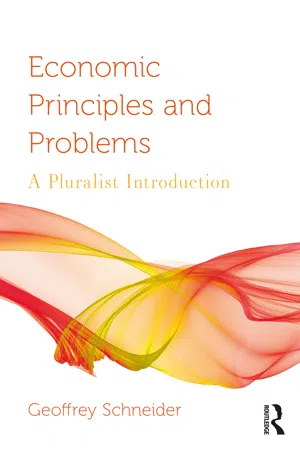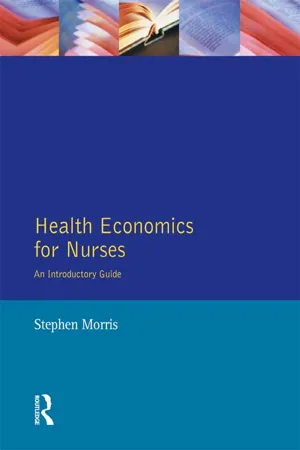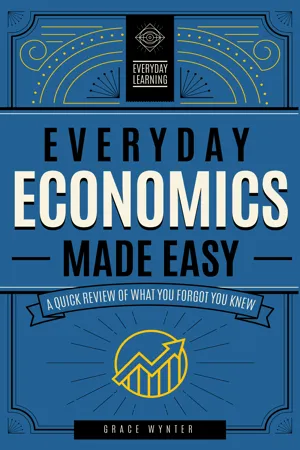Economics
Complementary Goods
Complementary goods are products that are used together to satisfy a particular need or want. The demand for one good is directly related to the demand for the other good. Examples of complementary goods include hot dogs and hot dog buns, or printers and ink cartridges.
Written by Perlego with AI-assistance
Related key terms
Related key terms
1 of 4
Related key terms
1 of 3
5 Key excerpts on "Complementary Goods"
- eBook - ePub
Practical Management for the Digital Age
An Introduction for Engineers, Scientists, and Other Disciplines
- Martin Baumers, John Dominy(Authors)
- 2022(Publication Date)
- CRC Press(Publisher)
unrelatedness. Among these, Complementary Goods play a decisive role. They can be defined as follows:A complementary good is one whose appeal increases if the popularity of another related good also increases. In other words, the demand for a complement increases if the price of another good decreases.Complementarity forms an extension of the concept of own-price elasticity of demand presented in Chapter 3 . If good A is a complement to good B, an increase in the price of A will result in a movement along the demand curve of A but it will also shift the demand curve of good B inwards. This means that less of both goods is demanded. Often-cited examples for pairs of complements are ground beef and hamburger buns, or left and right shoes. Complementarity is a very common relationship between pairs of goods, especially if one of the goods is an information good.In economics, this relationship is formally captured using the concept of cross price elasticity of demand (XED). This type of elasticity measures the responsiveness of demand for a good A following a change in the price of good B. Recall from Chapter 3 that the gradient of the demand function is related to the level of own-price elasticity of demand. XED establishes this relationship across two goods. It is defined as the percentage change of the quantity qA demanded of good A over the percentage change of price pB of good B:X E D =Δq A/q AΔp B/p B(4.1) To estimate XED, it is necessary to identify a base level of quantity qA 0 and price pB 0 and an altered level of quantity qA 1 and price pB 1 . This means XED is not constant along linear demand curves and it measures a percentage change from one state to another. Estimating XED is straightforward if qA 0 , pB 0 , qA 1, and pB 1 - eBook - ePub
Economics for Investment Decision Makers
Micro, Macro, and International Economics
- Christopher D. Piros, Jerald E. Pinto(Authors)
- 2013(Publication Date)
- Wiley(Publisher)
complements . Typically, these goods would tend to be consumed together as a pair, such as gasoline and automobiles or houses and furniture. When automobile prices fall, we might expect the quantity of autos demanded to rise, and thus we might expect to see a rise in the demand for gasoline. Ultimately, though, whether two goods are substitutes or complements is an empirical question answered solely by observation and statistical analysis. If, when the price of one good rises, the demand for the other good also rises, they are substitutes. If the demand for that other good falls, they are complements. And the result might not immediately resonate with our intuition. For example, grocery stores often put something like coffee on sale in the hope that customers will come in for coffee and end up doing their weekly shopping there as well. In that case, coffee and, say, cabbage could very well empirically turn out to be complements even though we do not normally think of consuming coffee and cabbage together as a pair (i.e., that the price of coffee has a relationship to the sales of cabbage).For substitute goods, an increase in the price of one good would shift the demand curve for the other good upward and to the right. For complements, however, the impact is in the other direction: When the price of one good rises, the quantity demanded of the other good shifts downward and to the left.4.5. Calculating Demand Elasticities from Demand Functions
Although the concept of different elasticities of demand is helpful in sorting out the qualitative and directional effects among variables, the analyst will also benefit from having an empirically estimated demand function from which to calculate the magnitudes as well. There is no substitute for actual observation and statistical (regression) analysis to yield insights into the quantitative behavior of a market. (Empirical analysis, however, is outside the scope of this chapter.) To see how an analyst would use such an equation, let us return to our hypothetical market demand function for gasoline in Equation 1-13 , duplicated in Equation 1-27 - eBook - ePub
Economic Principles and Problems
A Pluralist Introduction
- Geoffrey Schneider(Author)
- 2021(Publication Date)
- Routledge(Publisher)
Figure 9.8 (b) shows how the leftward shift in demand creates a surplus of soda (the line between point A and point B). As surplus soda builds up in inventories, soda companies like Coca-Cola and Pepsi cut back production and lower prices, moving the quantity supplied from point A to point C, the new equilibrium. As firms drop their prices, consumer demand moves from point B to point C.FIGURE 9.8 A shift in demand to the left (decrease in demand).9.6.3 The prices of substitute and Complementary Goods
Demand curves also shift when the prices of closely related goods change. A substitute good is a product that consumers are willing to purchase instead of another good; when the price of one good increases, many consumers will switch to buying the substitute good, increasing the demand for the substitute. A substitute for Coca-Cola is Pepsi. A substitute for beef is chicken. A complementary good is a product that consumers tend to purchase along with another good; when the price of one good increases and consumers buy less of it, there will also be a decrease in the demand for any Complementary Goods. Complements for peanut butter are bread and jelly. A complement for a cell phone is a case for the phone.As an example of substitute goods, when deciding how to heat their homes, households choose between electric, coal, wood, oil, and natural gas—these goods are substitutes for each other. As you can see in Figure 9.9 , the increase in the supply of natural gas from fracking has led to a dramatic drop in natural gas prices during the last decade, which has caused households to increase the quantity of natural gas demanded (moving along the natural gas demand curve down and to the right from point A to point B). There is a movement along the demand curve for natural gas because of the decrease in the price of natural gas. In the heating oil market, however, there is a shift in the demand curve for heating oil to the left as households buy more gas and less heating oil. Equilibrium in the heating oil market moves from point C to point D, with a lower equilibrium price and quantity. Note that in these graphs we use P 1 , P 2 , Q 1 , and Q 2 instead of putting in specific numbers. Economists are often interested in general trends in markets. In this case, economists were able to predict that the decrease in the price of natural gas and the increase in the quantity of natural gas demanded in Figure 9.9 (a) would be matched by a decrease in demand (leftward shift) for heating oil that we see in Figure 9.9 - eBook - ePub
Health Economics For Nurses
Intro Guide
- Stephen Morris(Author)
- 2014(Publication Date)
- Routledge(Publisher)
An example of substitutability is the relationship between butter and margarine. If the price of butter falls, then consumers will buy more butter, and therefore less margarine, and vice versa. An example of complementarity is the relationship between video recorders and video cassettes. If the price of video recorders falls consumers will buy more video recorders, and therefore will need to buy more video cassettes, and vice versa.4. TastesTastes, habits and customs may be extremely important in determining the demand for a good. A change in tastes in favour of a good, such as if a good becomes more fashionable, will cause an increase in demand. A change in tastes away from a good will cause a decrease in demand.A shift in demandAs shown in Figure 2.1 , a change in the price of a good will result in a movement along the demand curve, either up or down, depending on whether the price increases or decreases, respectively. However, a change in any other factor affecting demand will cause a shift in demand, shown by a movement, to the right or left, of the whole demand curve. This is shown in Figure 2.3 above.Figure 2.3 A shift in demand.Suppose an original demand curve characterised by D1 . The circumstances which might cause an increase in demand and a shift outwards to the right to D2 are:1. a rise in income of the consumer if the good is normal; 2. a fall in income of the consumer if the good is inferior; 3. a fall in the price of a complement to good A; 4. a rise in the price of a substitute to good A; 5. a change in tastes in favour of good A.The circumstances which might cause a decrease in demand and a shift inwards to the left to D3 are the opposite of these, namely:1. a fall in income of the consumer if the good is normal; 2. a rise in income of the consumer if the good is inferior; 3. a rise in the price of a complement to good A; 4. a fall in the price of a substitute to good A; 5. a change in tastes away from good A. SupplyWe will now examine the other side of the market, which is supply. The supplier is the basic unit which makes decisions about how many goods to supply or sell. The term supplier may be used interchangeably with the words sellers, producers, firms, businesses and enterprises. In this discussion we will use the term producers to refer to parties or individuals who supply goods. The quantity of goods which are supplied may also be referred to as the output of producers. - eBook - ePub
Everyday Economics Made Easy
A Quick Review of What You Forgot You Knew
- Grace Wynter(Author)
- 2022(Publication Date)
- Wellfleet Press(Publisher)
income increases or decreases, our demand for most products and services usually shifts. If you’ve always yearned for a luxury vehicle, the promotion you receive at the end of the year may allow you to finally make that purchase and donate your twenty-year-old beater to a good cause. As consumer income rises, overall consumption does too, meaning people buy more of the things they already typically purchase. They might go out to dinner more often or add a scone to their daily coffee shop latte order. The reverse is also true; as consumer income falls, so does consumption, and that one-a-day latte habit might morph into a once-weekly treat.PERSONAL TASTES AND PREFERENCES
Individual and collective preferences shape almost all market decisions. I’m not certain at what point in the 1980s huge bell-bottoms and tie-dye shirts fell out of favor, but at some point, they fell out of fashion and designers stopped making them. Culture, advertising, and the depletion or availability of resources all factor into changing consumer tastes, and they all affect demand. Personal tastes and preferences are probably the hardest to pin down category of demand influencers, but they play a large role in the type and quantity of goods consumers purchase, and companies spend millions of dollars each year to try to understand and influence them. We’ll spend more time analyzing this later when we talk about consumer theory.Complementary Goods
Certain goods that are usually used together—milk and cereal, hot dogs and hot dog rolls—are known as Complementary Goods , and the price of one of those items affects the demand for the other.EVERYDAY EXAMPLEYou’re in the grocery store doing your weekly shopping on a tight budget and marvel at the high prices of fresh vegetables. But as you peruse the produce aisles, you notice that the supermarket is having a blowout sale on Brussels sprouts, making them, by far, the cheapest fresh vegetables in the produce section. But there’s a problem: you hate Brussels sprouts, and even though at these prices the supermarket is practically giving them away, you wouldn’t touch them with a ten-foot pole. In this case, your personal preference overrides your demand for low-priced fresh vegetables.
Index pages curate the most relevant extracts from our library of academic textbooks. They’ve been created using an in-house natural language model (NLM), each adding context and meaning to key research topics.
Explore more topic indexes
Explore more topic indexes
1 of 6
Explore more topic indexes
1 of 4




